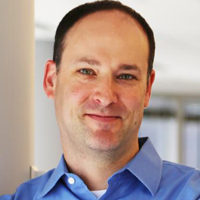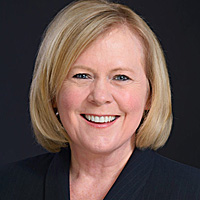
Scripps: ‘Plus-Fatigue’ Will Drive OTA Growth

Having recently announced a $20 million consumer campaign to encourage broadband homes to add over-the-air TV antennas, E.W. Scripps Co. President-CEO Adam Symson used a Deutsche Bank Media, Internet and Telecom Conference Tuesday in Palm Beach, Fla., to lay out for investors the marketplace opportunity.

Adam Symson
“About one in four broadband homes today uses an antenna in order to get free, over-the-air television,” Symson told the gathering. “There was an entire generation that didn’t realize television was free, and now those consumers are plugging in new antennas.
“Typically, they’re doing so to identify live sports and local news — and when they do that they recognize an entirely new universe of premium programming,” he said. “That’s happening. That marketplace has grown to about 35% of U.S. households — with no support. And it’s happened because people have recognized the value of free television bundled together with their SVOD services. Our work now is going to be to accelerate that growth. We think that marketplace will naturally grow to between 45% and 55% of U.S TV households.”
He then cited a couple of consumer trends favoring OTA growth.
“Consumers are suffering from ‘plus-fatigue.’ We’re in the point now where there are so many SVOD services that consumers on average are paying $142 for internet access and subscription services, which is frankly more than they were paying for pay TV. Pay TV averages between $95 and $100,” the CEO noted. And he added that those bills help explain some “equilibrium” in cord-cutting, where cable sub declines have slowed.
“The cord-nevers have recognized also that they want to watch their NFL. They want to watch premium programming. So, they’re adding on a digital antenna and they’re recognizing also that out of the top 25 streamed shows on the SVOD services, virtually all of them are also available for free over the air,” Symson said.
While other media companies have been focusing on growing SVOD, Symson said the acquisition of Ion completed the five-year transformation of Scripps into a free television company. What are now nine OTA digital networks each reach over 95% of U.S households, adding to the large portfolio of local broadcast TV stations that Scripps assembled, mostly after the 2015 exit from its historic newspaper business dating back to 1878.
“The local marketplace has been attempted by many different media in the past,” Symson said. “And the reality is television still continues to be the most important way for people to get their cash registers to ring. The local, mainstream economy runs on television advertising. You don’t see consumers reminiscing about their favorite search word. Nobody is thinking about their most recognizable Facebook targeted ad. What they recall is the brand power of local television and of television in general.”
“Our local news is really our biggest differentiator,” said Brian Lawlor, president of local media at Scripps. “And I think that that’s our brand. More of our research says that local news is the most trusted source of news — and I think that’s our connection to the community.

Brian Lawlor
“Local TV stations probably mean more to local communities than any other medium, locally,” Lawlor added. “That’s our biggest point of differentiation. We bring communities together. We are a voice that is trusted. We’re a safe place for advertisers to put their brands out. We’ve got decades of proven success.”
When Scripps reported its fourth quarter and full year 2021 results on Feb. 25, the company upped its political ad guidance for this year to exceed not just the previous mid-tern election, but even the record presidential year of 2020. Moderator Connor Murphy of Deutsche Bank wanted to know whether local broadcasters, though, will lose any share to digital.
“Local gets laid in first and then digital,” Lawlor said. “If we had more inventory, if we had more time, we’d be able to take more. We’re not like newspaper — we can’t add a page, and so there’s only so much we can consume.”
Even without a presidential race, Lawlor said spending will come not only from hot Senate and gubernatorial races, but down-ballot races and issues as well.
“There will be more money in the ecosystem than there’s ever been in a mid-term,” he said.
While auto advertising, once TV’s bread-and-butter category, continues to lag due to supply chain challenges, Lawlor was asked to describe the growth of TV’s hot new category — online sports betting.
“As I think about where we’re at in the cycle, I’m thinking in terms of thirds,” he said. “I still think we’re in that first third. In my mind, the first third is states ratifying. We’ve seen what, 30, 31 states so far ratify it, so there’s still a good bit of the country that needs to legalize sports betting. I think once that happens, that kind of completes the first part.
“The next part is not every state looks the same,” he said. “The rules for online gambling are going to look very different. I think there’ll have to be a standardization then. Once that happens, then we’re able to move to an opportunity for in-game sports betting. As we look at Europe and other places, the majority of dollars spent in sports betting happen in-game.”

Lisa Knutson
Is the Russian invasion of Ukraine having any impact on advertising? Lisa Knutson, president of Scripps Networks, said buys are coming in a little later as advertisers try to address new supply chain disruptions. But as the local side prepares for a big boost from political, she is taking that big portfolio of nine networks to national advertisers for upfront commitments.
“We’re seeing growth from our successful upfront last year,” she noted, having already reported 10% year-over-year growth for the most recent quarter.
Knutson and Symson both noted that Scripps Networks had quietly nailed down streaming rights for all of its OTA network programing. So, while Scripps is not jumping into paid streaming, its advertiser-supported networks began launching on all major platforms beginning in the fourth quarter of last year.
































Comments (0)